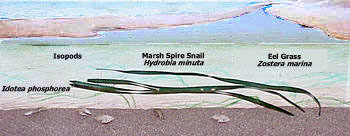| |
|
 |
Spits and beaches are the most exposed habitats. Only a few hardy species
can survive the wind, waves, salt spray, moving sand, summer heat,
dryness and low food supply. Decomposing seaweeds and animal matter
washed up by the tides are major sources of nutrients.
|
 Seabeach-sandwort
has fleshy leaves and stems which store water and resist sandblasting.
Cacti have similar adaptations. Seabeach-sandwort
has fleshy leaves and stems which store water and resist sandblasting.
Cacti have similar adaptations.
Honkenya
peploides

Cakile edentula
Sea-rocket has seed-pods in two parts to double its chances of reproduction.
The top half breaks off and floats to a new site. The bottom half
stays attached to the plant and germinates there.
|
Lake Wallace:

A brackish lake
on South Beach, Lake Wallace's inhabitants must tolerate
extreme and sudden changes in salt content and temperature.
In winter, storm waves flood the lake with salt water, causing
it to stretch for 8 km (5 miles). In summer, it shrinks
to one kilometre in length.
|
Home
| Nature | History
| Sable Today | Fun
| About | Feedback
| Franšais
|









